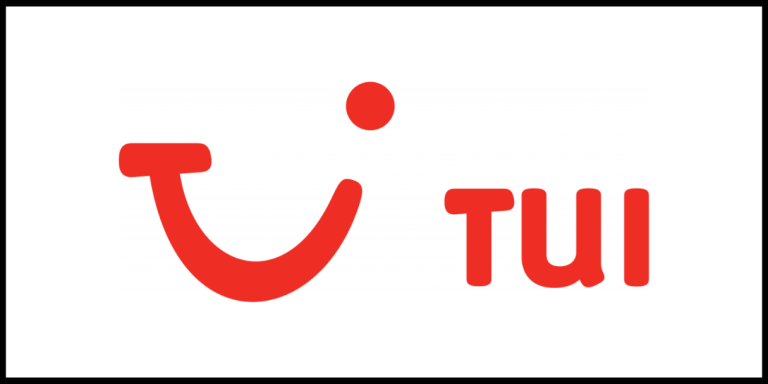top 10 recommendations: hiring, retaining and progressing women in tech
BY MADIHA MUBARIK
Home » Diversity & Inclusion Report on Top 10 Recommendations: hiring, retaining and progressing Women in Tech
New analysis suggests that by 2025, there will be just one qualified woman for every 128 roles in technology, globally. According to Accenture, half of women in tech drop out by the age of 35, meaning that we look to a future where technology continues to be built and governed by the majority.
This is not a future that we want. So, Code First Girls has created a report in collaboration with the Tech Talent Charter (TTC) to provide employers with actionable recommendations for hiring, retaining and progressing women in their technical teams.
In our collaborative report, Code First Girls and TTC have drawn on data from the largest community of qualified female software engineers and employees of TTC businesses across the UK including Gymshark, the Scottish Government, GCHQ, Transport for London, and Shell.
Attracting and empowering women in tech
Despite more women entering the workforce each day, the tech industry continues to face a significant gender gap. According to Tech Nation, 26% of people working in technology in the UK are women. We wanted to understand the barriers that are holding women back – so we asked our community.
The results show that the majority feel a lack of confidence in pursuing a job in technology, whilst 59% felt that there was a preconception that the industry is still for men. This highlights the need for prominent women role models and mentorship to provide women with the skills that they need to grow in confidence and excel in their roles.
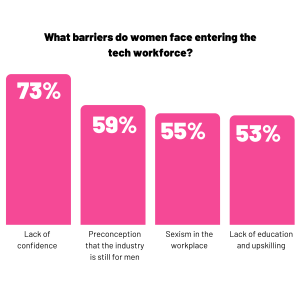
First stop, job adverts
As an employer, if you are working to address the barriers faced by women entering the workforce, reviewing your job descriptions and hiring processes is a great place to start. We asked our community of newly qualified software developers how organisations can appeal to them and we found that a majority of women are looking for salary information, flexible working options and career progression in job adverts.

Notably, 44% prioritise remote work possibilities, while 31% emphasise job security. This highlights the need for companies to adjust their job adverts ensuring transparency and openness regarding salary, flexible or remote work options, and career growth. By doing so, companies can foster an environment that encourages women to apply and contribute their talents.
Highlighting best practices for tech talent attraction
The Tech Talent Charter also engaged its signatories, compiling a list of common practices that are widely in use across organisations in order to support the attraction of diverse technical candidates:
- Implementing flexible working and enhanced parental leave policies
- Using standardised interview questions for a fairer hiring process
- Anonymising applications and using independent scoring by multiple assessors
- Running returners programs to help experienced professionals return to work
- Using text decoders to neutralise biassed language in job descriptions
- Career progression programs that support internal talent to move into new roles
- Working with skills providers to source tech talent from non-traditional pathways
#1 is flexible working
Flexible working came top of both our community’s requirements and TTC Signatories recommendations. Offering job flexibility upfront in job ads has been shown to increase the volume of applicants by up to 30%, as well as increasing the proportion of female applicants. Flexible working has remained a key issue for increasing the number of women (and other groups such as disabled people) in tech.
TTC asked Signatories about their flexible working practices and found that the vast majority of organisations are providing a broad range of flexible working options to tech employees, with nearly 1 in 2 tech workers able to work remotely as much as they like. Other more unique practices included a 4.5 day week, a seasonal shorter week, where the work week is reduced to 4 days during school holiday periods, and uncapped holiday.
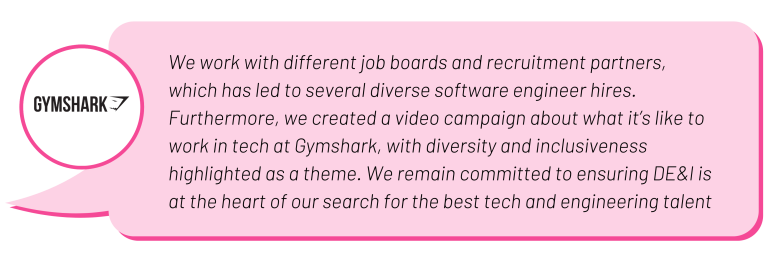
Now that we know why women are leaving roles, what can employers do to retain them?
Building an inclusive culture is key to retaining women in tech, as it helps eliminate biases and stereotypes while encouraging diverse perspectives and fostering innovation. By creating a sense of belonging, women feel supported and motivated, leading to increased loyalty.
Inclusive cultures also provide equal career advancement opportunities, improving women’s chances of success. On top of that, accommodating work-life balance and promoting positive role models inspire and empower women. An inclusive culture is essential for women to thrive, contribute their talents, and stay committed to the tech field.
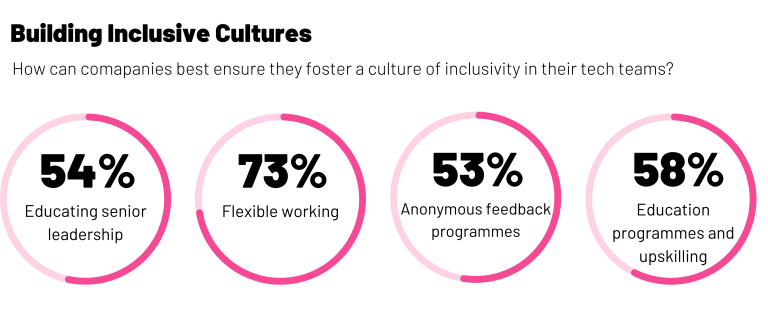
Breaking down barriers to progression: How to drive fair progression
One striking statistic revealed that only 2% of our community members have ever been given the opportunity to upskill while at work. We recognise the importance of empowering women into tech leadership by offering career planning and progression opportunities. It is essential to address the various factors that impede women’s growth, such as stereotyping, maternity leave, family-life balance, and double standards.
Organisations must take steps to dismantle these barriers and create a level playing field for women to thrive and ascend into leadership roles. So we asked our community what organisations can do to empower them, the majority pointed out career planning and progression and a supportive work culture. Others mentioned addressing bias and stereotypes and having a supportive senior leadership.
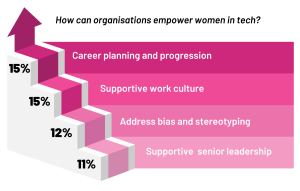
Driving change: 10 key recommendations for boosting gender diversity in tech
Drawing on our extensive experience and research, together with TTC, we have curated 10 key recommendations to improve the proportion of women in tech.- Flexible working: Offer a range of flexible work options with upfront discussion in the hiring process. Consider options that help with parental responsibilities, like greater flexibility for school holidays.
- Audit systems of bias: Consider all processes in the career lifecycle, such as recruitment, promotion, and performance decisions.
- Offer tech skills programmes: Demonstrate a commitment to career progression and enable employees to grow in their careers within the company.
- Engage with or run reskilling and returners programs: Facilitate career mobility and provide routes into tech careers for future talent and experienced professionals.
- Enhanced family leave policies: Particularly for longer periods away from work; leading companies are offering full pay for 6 months for maternity leave and 4 months for paternity leave.
- Fair remuneration: Demonstrate fairness in remuneration decisions through salary transparency in recruitment and pay parity measurement within the organisation.
- Reproductive health care: Implement policies and cultural behaviour that support employees with reproductive health, such as benefits for infertility disease, menstrual health and menopause.
- Conduct regular listening activities: Create safe environments where your employees can feedback. Conduct listening activities to understand how included, safe and valued they feel at work.
- Support healthy work-life balance: Take individualised approaches to employee support in both well-being and professional development. Enact digital wellness practices that support healthy work-life balance.
- Develop robust HR practices: Cultivate an inclusive and safe workplace culture where employees feel safe to share concerns and challenges and develop robust HR practices to deal with emerging issues.










